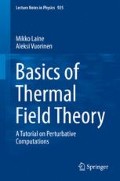Abstract
A fermionic (spin-1/2) field is considered at finite temperature. Starting with a fermionic analogue of the harmonic oscillator and proceeding to the case of a field satisfying a Dirac equation, an imaginary-time path integral representation is derived for the partition function. This leads to the concept of Grassmann variables satisfying antiperiodic boundary conditions. The corresponding Matsubara frequencies are introduced, the partition function is evaluated in the low and high-temperature expansions, and the structures of these expansions are compared with those of a scalar field theory.
Access this chapter
Tax calculation will be finalised at checkout
Purchases are for personal use only
Notes
- 1.
Rapidly convergent sum representations in terms of the modified Bessel function can, however, be obtained: \(\tilde{J } _{T}^{}(m) = -\frac{m^{2}T^{2}} {2\pi ^{2}} \sum _{n=1}^{\infty }\frac{(-1)^{n}} {n^{2}} K_{2}^{}(\frac{nm} {T} )\), \(\tilde{I} _{T}^{}(m) = \frac{mT} {2\pi ^{2}} \sum _{n=1}^{\infty }\frac{(-1)^{n}} {n} K_{1}^{}(\frac{nm} {T} )\).
Reference
F.A. Berezin, The Method of Second Quantization (Academic, New York, 1966)
Author information
Authors and Affiliations
Appendix: Low and High-Temperature Expansions for Fermions
Appendix: Low and High-Temperature Expansions for Fermions
Defining the fermionic sum-integrals
we first divide them into zero and finite-temperature parts via
where we have used the fact that at T = 0, the integrals reduce to their bosonic counterparts, i.e. \(J_{0}^{}(m)\) and \(I_{0}^{}(m)\) from Eqs. (2.70) and (2.73), respectively. In the following, our goal is to find general expressions for the functions \(\tilde{J } _{T}^{}(m)\) and \(\tilde{I}_{T}^{}(m)\). In addition we work out their low and high-temperature expansions, noting in particular the absence of odd powers of m in the high-temperature limits. Finally, we also determine the fermionic version of Eq. (1.78),
Let us proceed according to Eq. (4.55). From Eq. (2.50), i.e.
we immediately obtain
whereas from Eq. (2.53), i.e.
the same steps as in Eq. (4.58) lead us to
Unfortunately these integrals cannot be expressed in terms of known elementary functions.Footnote 1
Concerning the expansions, we know from Eq. (2.79) that the low-temperature limit of \(J_{T}^{}\) reads
In Eq. (4.55), the first term is exponentially suppressed, and thus we obtain in the fermionic case
From Eq. (2.80), the low-temperature expansion for \(I_{T}^{}\) reads
Again, the first term in Eq. (4.55) is exponentially suppressed, so that we get
Moving on to the high-T limit, the high-temperature expansion of \(J_{T}^{}\) reads from Eq. (2.82)
According to Eq. (4.55), we then get
where we note in particular the disappearance of the term cubic in m. Finally, from Eq. (2.93), we may read off the high-temperature expansion of \(I_{T}^{}\),
which together with Eq. (4.55) yields
Again, the term odd in m has disappeared. Note also that the term \(-2m^{2}\ln (m)/(4\pi )^{2}\) is T-independent and cancels against a corresponding logarithm in \(I_{0}^{}(m)\) if we consider \(\tilde{I}(m,T)\), cf. Eq. (2.73), so that \(\tilde{I}(m,T)\) is formally a genuine power series in m 2.
Finally, we know from Eq. (1.70) that the bosonic imaginary-time propagator reads
Employing Eq. (4.55), we obtain from here
For good measure, we end the section by rederiving Eq. (4.77) more directly, similarly to the procedure applied around Eq. (2.30). Consider the auxiliary function
which has poles at \(\exp (i\beta p) = -1\), i.e. \(p =\omega _{ n}^{\mbox{ f}}\). The residue around each of these poles is
Therefore, letting f(p) be a generic function regular along the real axis, we can write
where the integration contour runs anti-clockwise around the real axis of the complex p-plane. Choosing then
we note that for 0 < τ < β both half-planes are “safe”, i.e. \(e^{ip\tau }n_{\mbox{ F}}(ip)\) vanishes fast for \(p \rightarrow \pm i\infty\). (The values for τ = 0 and τ = β can be obtained in the end from continuity.) Therefore we can close the two parts of the integration contour in a clockwise manner in the upper and lower half-planes, respectively. Picking up the poles of f(p) from ± iω, this yields
and noting that
we directly obtain Eq. (4.77).
Rights and permissions
Copyright information
© 2016 Springer International Publishing Switzerland
About this chapter
Cite this chapter
Laine, M., Vuorinen, A. (2016). Fermions. In: Basics of Thermal Field Theory. Lecture Notes in Physics, vol 925. Springer, Cham. https://doi.org/10.1007/978-3-319-31933-9_4
Download citation
DOI: https://doi.org/10.1007/978-3-319-31933-9_4
Published:
Publisher Name: Springer, Cham
Print ISBN: 978-3-319-31932-2
Online ISBN: 978-3-319-31933-9
eBook Packages: Physics and AstronomyPhysics and Astronomy (R0)

